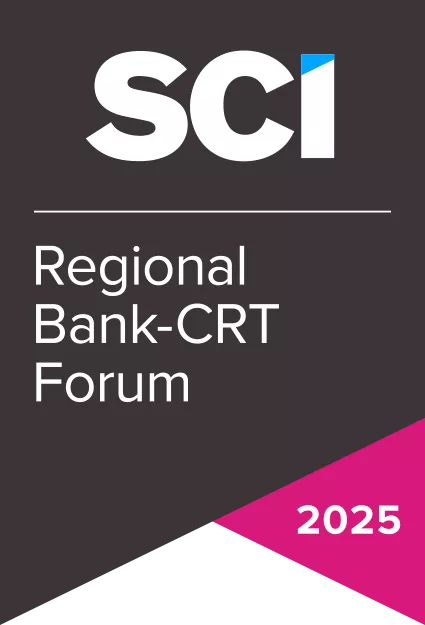With regional and smaller banks now actively executing capital relief trades, this event offers treasury and structuring teams a focused forum to explore SRT execution, investor engagement, and deal structuring strategies.
“It feels like momentum is building for significant growth in the US CRT market, led by regional banks. This forum is an important opportunity for market participants to gather, and discuss regulatory considerations, optimal structures, and different approaches.”
- Terry Lanson, Managing Director, Seer Capital Management
Please note, regional banks new to CRTs, or looking to become first-time CRT issuers, can claim a complimentary pass by getting in touch with us directly.
Event Date
Location
Agenda
Registration Opens & Networking Breakfast
Welcome Note & Opening Remarks
Speakers

Simon Boughey, SCI US Editor
Teach In/Workshop
US SRT 101: A Primer on US SRT & Applications for US Regional Banks
- History of the US Market
- Regulatory Drivers
- Applications for Prospective Issuers
- Catalysts for Future Growth
Speakers

Mark Kruzel, PIMCO
What Are the Motivations and Impediments for Issuing a CRT Trade?
Pros:
- Capital relief and balance sheet optimization
- Hedging credit exposures and concentration risks (particularly in CRE exposure)
- Option for customized solutions to meet bank specific needs
- Cheaper alternative to issuing equity
Cons:
- Regulatory uncertainty around Basel Endgame, etc
- Reluctance to go out on a limb / be one of the first issuers
- Costs of entering the CRT market
- Data challenges:
- Producing loan-level information required for CRT transactions
- Evaluating and confirming eligibility criteria for reference assets
- Lack of historical loss and delinquency data for regional banks
- Difficulty tracking losses and recoveries as required by CRT
- Logistic challenges:
- Many regional banks lack a capital markets arm
- Lengthy education process which often begins at C-Suite
- Inherent limitations:
- Regional banks may have less sophistication in structured finance
Speakers

Chip Salter, Wells Fargo Securities

Darren King, Merchants Capital

Brian Gilbert, Pinnacle Financial Partners

Gareth Old, Clifford Chance

Jalpesh Patel, Ally Bank

Sagi Tamir, Mayer Brown (Moderator)
Networking Break
Beyond CRT – Credit Insurance as a Tool for US Regional Banks
• Market Trends and Future Outlook:
o How is credit insurance currently being used in Europe?
o What’s the current usage and adoption level among US regional banks?
• Benefits of Credit Insurance for Regional Banks:
o What are the key advantages of credit insurance for regional banks?
o What practical use cases exist in the US, and how many institutions are adopting it?
• How Can Utilizing Credit Insurance Improve Your CRT Program?
o How can credit insurance complement or improve a CRT program?
o How does it help address challenges related to data, eligibility, and structuring?
o Are there notable regulatory distinctions between insured exposures and traditional CRTs?
• Investor and Market Perception:
o How are insurance-enhanced CRTs viewed by investors and counterparties?
o What do investors look for in CRT deals from regional banks?
o How can insurers support smaller or first-time CRT issuers?
Speakers

Jeff K. Davis, Mercer Capital

Jennifer Bearden, IACPM

Mark van der Does, Lockton Re (Moderator)

Richard Abizaid, MSIG USA
Networking Lunch
What Regulatory Initiatives Will the New Administration Bring?
- Securitization Market Priority:
- How high of a priority is the securitization market for the new administration?
- Leadership Changes at Regulatory Agencies:
- How might new heads of agencies affect the securitization market?
- Will they adopt a more favourable or lenient approach to securitization?
- Approval Process for CLNs:
- Will the Federal Reserve’s approval process for CLNs become easier and faster?
- Restrictions on SPV deals:
- What regulatory changes / clarifications are needed to facilitate the issuance of tranched and syndicated SPV deals?
- What is the current status of Commodity Pool relief, and what updates or guidance might be forthcoming?
- How do updates to relevant regulatory guidance or relief affect SPV feasibility and structure selection?
- Is this the optimal structure for the market?
- Basel III Endgame:
- Is the Basel III endgame still a viable plan? What impact will this have on the CRT market?
- Current Regulatory Landscape:
- What does the current regulatory backdrop look like for regional banks in the $100bn-$250bn range?
Speakers

Michael Shemi, Guy Carpenter

Amanda Baker, Mayer Brown (Moderator)

Joseph Hwang, Goldman Sachs

Tom Killian, TWK Advisors LLC
Speed Dating Session 1 – Meet the Issuers
Structural Preferences and Asset Mix
- What structures make sense for regional banks, and why?
- How does this vary by size and type of institution?
- Direct Bank CLN vs. CDS Structures:
- Is a direct CLN a more straightforward pathway to CRT compared to structures involving credit default swaps or financial guarantees with a counterparty?
- SPV-Issued CLNs and other solutions for Smaller Regional Banks:
- How do limits on ability to tranche and syndicate affect the attractiveness of the SPV structure?
- Are SPV-issued CLNs a viable option for smaller institutions?
- Are direct CLNs more suitable for regular ABS issuers?
- Benefits of “Cash” CRT or securitization structure involving loan sales
- Credit Limits and Regulatory Capital:
- How do regional banks' strict credit limits for exposure, investment, and regulatory capital influence structuring options?
- Bilateral vs. Syndicated:
- Which model makes more sense for regional banks?
- CRT Deals for Smaller Banks:
- What is the minimum bank size to engage in a CRT deal? (e.g., Third Coast is $5bn)
- Asset Considerations:
- Which assets are most suitable for CRT transactions? (e.g., car loans vs. corporate loans)
Speakers

Artem Chernovolenko, Barclays

Chip Salter, Wells Fargo Securities

Jeremy P.G. Hermant, Alantra

James Bryson, A&O Shearman (Moderator)

Karan Chabba, Eagle Point Credit Management
Speed dating session 2 – Meet the Investors
The Future of CRT for Regional Banks
- Market Trends and Future Outlook:
- What does the future hold for CRT issuance by regional banks?
- How are regional banks preparing for evolving market conditions and regulatory changes?
- SRT Strategies Gaining Traction with LPs:
- How are LPs viewing risk transfer transactions, and what’s driving their increased participation?
- What does growing LP interest mean for structuring and execution of future SRT deals?
- How to address concerns around counterparty risk?
- Technology and Innovation in CRT Transactions:
- What does growing LP interest mean for structuring and execution of future SRT deals?
- Investor Sentiment:
- How do investors view CRT deals from regional banks? What do they look for in terms of risk and return?
- Cross-Market Lessons:
- What lessons can regional banks learn from international CRT activity?
- How can novel structures from other markets—such as European repack innovations—be adapted to help U.S. issuers access broader capital and risk transfer options?
Speakers
Eric Andersson, iconicchain

Mark Kruzel, PIMCO

Sara McGinty, Ares Credit Group

Sean Hannah, Lockton Re (Moderator)

Terry Lanson, Seer Capital

Wilson Pace, Raymond James
Drinks Reception
Delegate Pricing
Subscriber Rates
Early Access
Regular
Final Release
Non-subscriber Rates
Early Access
Regular
Final Release
Register Your Place
Platinum Sponsor

Silver Partner



Exhibitor

Speakers

Artem Chernovolenko, Barclays

Chip Salter, Wells Fargo Securities

Darren King, Merchants Capital
Eric Andersson, iconicchain

Jeff K. Davis, Mercer Capital

Jeremy P.G. Hermant, Alantra

Michael Shemi, Guy Carpenter

Simon Boughey, SCI US Editor

Amanda Baker, Mayer Brown (Moderator)

Brian Gilbert, Pinnacle Financial Partners

Gareth Old, Clifford Chance

Jalpesh Patel, Ally Bank

James Bryson, A&O Shearman (Moderator)

Jennifer Bearden, IACPM

Joe Koebele, Lockton Re (Moderator)

Joseph Hwang, Goldman Sachs

Karan Chabba, Eagle Point Credit Management

Mark Kruzel, PIMCO

Mark van der Does, Lockton Re (Moderator)

Richard Abizaid, MSIG USA

Sagi Tamir, Mayer Brown (Moderator)

Sandro Kraft, Valley National Bank

Sara McGinty, Ares Credit Group

Terry Lanson, Seer Capital

Tom Killian, TWK Advisors LLC

Wilson Pace, Raymond James
Advisory Board

Jalpesh Patel, Ally Bank

Chip Salter

Daniel Esposito

James Bryson, A&O Shearman (Moderator)

Jeffrey Hinkle

Joe Koebele

Sandro Kraft, Valley National Bank

Sean Hannah

Terry Lanson, Seer Capital

